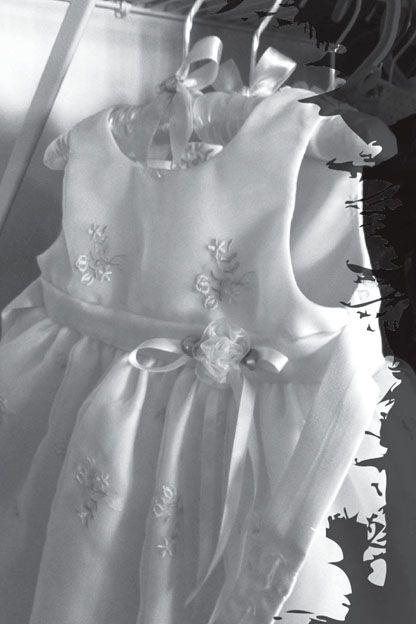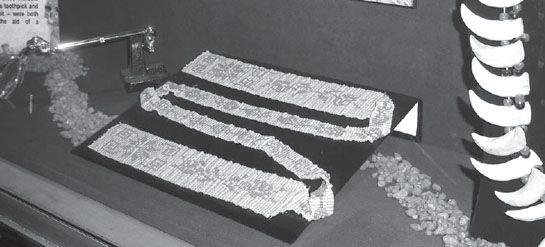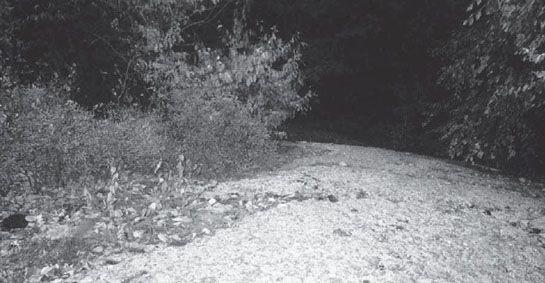Haunted Objects: Stories of Ghosts on Your Shelf (4 page)
Read Haunted Objects: Stories of Ghosts on Your Shelf Online
Authors: Christopher Balzano,Tim Weisberg


Some Things Are Better Left Dead
Mary Ann and her husband were visiting an antiques shop not far from home one day when she spotted a faded pink parasol. It had a wooden handle and a tear in the material, with a yellow stain on one side of it. Mary Ann liked it, but the price tag said $60—far more than she wanted to spend.
Two weeks later, while perusing a local thrift shop with one of her friends, Mary Ann found what seemed to be the exact pink parasol. It, too, was faded, had a wooden handle, and had a tear with a yellow stain. Amazed, Mary Ann looked it over to be certain it was the same parasol. She wasn’t going to leave it behind a second time, especially after she saw the price tag—just $5.
As she drove home with her friend, she remarked about how strange it was that the same parasol would go from an antiques shop to a thrift shop in only a matter of weeks, and then be sold for substantially less than it was priced just a short time before.
When she showed it to her husband, he agreed that it appeared to be the same parasol. They figured it was a stroke of good fortune that led Mary Ann to the parasol in the thrift shop. Perhaps, she thought, she was fated to own it.
She placed the parasol against their brick fireplace, the perfect spot to display her new treasure. Then she and her husband and friend continued on with their day.
Later, the three decided to go out for dinner. While they were upstairs changing their clothes, they heard a loud crash downstairs and ran to see what had happened.
The fireplace screen had tumbled to the floor. The fireplace tools, which had been tucked inside the fireplace for the summer, were strewn over the floor, several feet away from the fireplace itself. The only thing left untouched was the pretty pink parasol.
Mary Ann’s husband suggested maybe the cat caused the ruckus, but the animal was standing next to them, looking just as bewildered. It, too, had apparently been upstairs at the time of the crash.
They scratched their heads and began to wonder about that parasol. Perhaps the reason it had shown up in a thrift store at such a low price was because it was haunted. Whoever had purchased it from the antiques shop must have taken it home, had their own strange incident, and immediately donated it.
Mary Ann decided that was a good idea. She donated it back to the thrift shop—and the fireplace screen and tools never fell again.
The Belt That May Have Started It All
Researching haunted objects involves noting how things can be altered when such an object is present. Something is drawn to or kept in place by the item. Watching the way a spirit interacts with an object tells you something about both of them.
There are other times when a haunting is defined by something that is not there. In that case, the absence of an item that once proved to be a powerful symbol of someone’s life can cause an imbalance. When that missing symbol has meaning for more than one person, when it may even be the connection many people have to a common history, it can spark something worse.
Most curses are active things, placed on people or places in times of vengeance or stress. They are invoked by the living, and they need to be nourished or they die. Many people think that believing in a curse might continue to give it energy even after the original person, who uttered the curse, has died.
The Wampanoag wampum belts fall somewhere between the two. There is no doubting their importance to a nearly wiped-out culture and their connection to a famously haunted area of the country. What we don’t know is whether a spiritual explosion—which at times can be spooky and at other times downright dark—is part of an energy imbalance or is caused by a curse that remains active until the item in question finds its way back to the ones who revere it.
The reason doesn’t really matter to those caught in the storm—they are just trying to understand what is happening to them and perhaps seek shelter from it.
New England is the heart of haunted America. With its architecture, long history, and dark and stormy nights, it has been the archetypical location for the ghost story since Nathaniel Hawthorn handed his mantle to people like H.P. Lovecraft and Stephen King.
In a corner of Massachusetts, right on the border with Rhode Island, lays an area known as the Bridgewater Triangle. Depending on which authority you listen to, the Triangle might stretch anywhere from the edges of Plymouth Rock all the way across the Nutmeg State. The highest concentration of paranormal activity in the country lies in this relatively small area.
Within the Triangle, anything is possible. It has been the home of UFO and Bigfoot sightings and the ground over which zombies are said to crawl. Ghosts
are around every corner. Some towns embrace their haunted histories, while others wish everyone would stop talking about them. And while it may be the playground of supernatural creatures like giant thunderbirds and pukwudgies (troll-like demons), the area’s high number of unusual murders, suicides, and cases of mental health disorders separate it from other places in the country that also experience ghostly phenomena. The Triangle has always been judged by the things that happen there, and the closer you look and the further back you go, the more you come to believe that the continuing activity is due to a lost belt.

These Wampum belts at the Ripley’s Believe It or Not Museum in Key West, Florida, are similar to those that were taken from Anawan.
The Wampanoag tribe met the Pilgrims when they first landed in this country, and at the time, they were the dominant people in the area. Although they had been hit by disease in the years leading up to the arrival of the Pilgrims, the Wampanoags’ connection to other tribes throughout New England and their entrenched political and social systems made them a major force. Like most Native American tribes, they had no formal written language and passed on much of their belief system and history through the oral tradition. The map to their past and to who they were as a people was a series of wampum belts worn by the sachem, or leader, of the tribe. Although there is no visual record of what these belts looked like, research has uncovered certain details.
According to anthropologist and author Charles Robinson, the belts would have been about nine inches wide and could have wrapped around an average-sized man several times. Each belt would have consisted of shells and other natural elements, some worn through years of use. The most common colors may have been black and white, but similar belts from other tribes featured red, gray, and purple as well, with significance added to the color, shape, and size of each new shell that was added.
During ceremonies, the sachem would tell the history and important moments of the tribe, noting the shells that related to those moments, like a person taking out the items of a time capsule and telling our modern history through them. It was the job of the younger generation to listen and learn and eventually pass the stories on to the next generation. Until they learned to read and write, this was how the Wampanoag’s history was recorded. By the time they began to record the stories in writing, they had already been influenced by the religious and social ideas of the European settlers who had converted them.
In 1675, war broke out between the people of Plymouth Colony and the Wampanoag, with most of the tribes in the area choosing sides. King Philip’s War all but destroyed the Native American presence in New England. There are many causes of the war, and some might say the conflict was inevitable as soon as people crossed the Atlantic Ocean, but there are two definite things you can say about that dark year in America’s history. The first is that the bloody nature of the war reflects the worst in human nature. The second is that the wampum belts, which had passed through many hands in the preceding years, were lost, and the true history of the Wampanoag was lost along with them.
Massasoit, the sachem in charge when the Pilgrims landed, passed the wampum belt to his son, Alexander, upon his death. In turn, Alexander passed it on to his brother, Philip, who wore the belt through the beginning days of the war named after him. As the fate of the war seemed certain, Phillip gave the belt to his general, Anawan, for safekeeping. Philip’s visions held true for he was betrayed by one of his confidants and killed. Anawan, knowing ultimate defeat was near, surrendered in August 1676 and was stripped of the belt. Whatever became of it after that is unknown.
In his book,
True New England Mysteries: Ghosts, Crimes, and Oddities
, Robinson offers some possible locations for the belt based on his research. He records that General Benjamin Church did receive the belt and shipped it to England. He also found references to the belt in letters to and from England, but not proof it ever arrived. Perhaps it was lost at sea or never cataloged when it was unpacked. Or perhaps the authorities had no desire to log all the treasures of war that passed across their desks. What is clear is that few people across the pond would have understood the significance of the belt, and even fewer would have appreciated it. Despite efforts in recent years to confirm its location in England, the belt remains lost.
It would remain just a footnote, a historical mystery, if the oddities in the Bridgewater Triangle—the site of so many emotional high points of the war and the heart of Wampanoag culture today—didn’t have so many connected hauntings.
On Route 44, considered by some to be a type of paranormal artery running through the Triangle, a lasting tribute to the Plymouth betrayal draws in locals and paranormal investigators alike. The site of Anawan’s surrender and the place where he was stripped of his belt is one of the most notorious places people go to look for ghosts. In fact, people not looking for ghosts often find them there as well. People have heard voices chanting and yelling in what has been translated to be Algonquin Indian. Small fires that give off no heat or sound appear and disappear. Even phantom Wampanoag warriors roam, often ready to fight when they come across visitors.
Profile Rock, part of the Freetown State Forest, also has its share of spectral sightings. Some written sources say Anawan received the belt from Philip at that spot, and then stayed there to try to contact his father in the spirit world. Philip’s ghost has been seen on the rock. Witnesses who have seen a man sitting there with his legs crossed say he vanishes when they approach. A few have seen a translucent man standing with his arms outstretched.

Anawan Rock, site of the final betrayal.
The list goes on: A disturbed burial site causes all the workers who discovered it to relive battles from the King Philip’s War; a couple who took a memento from another disturbed site were troubled when a ghost dressed like a Native American kept visiting them at night. Time after time, witnesses within the Triangle report running into spirits who they identify as Wampanoag. Some are brief encounters, while others last years.
A news article in 2004 reported that an unidentified Wampanoag spiritualist said the murder and violence in the Freetown State Forest, which has made it infamous on a national scale, would continue until the belt was returned. It was the first time anyone made such a claim on the record. In the years that followed, others have made the connection between the violence and the paranormal activity there. The tribe now uses the forest as a reservation, so it would make sense that any curse would be concentrated in the place they now call home.
